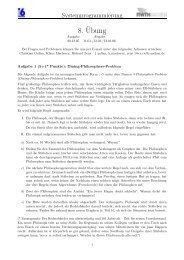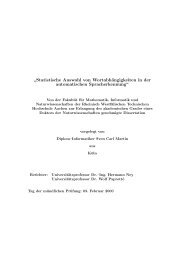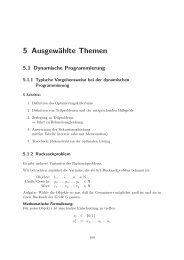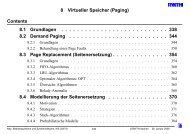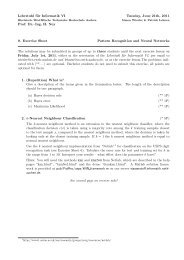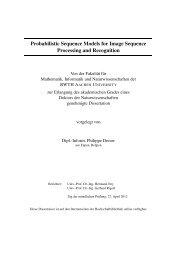n o h Y - Www I6 Informatik Rwth Aachen - RWTH Aachen University
n o h Y - Www I6 Informatik Rwth Aachen - RWTH Aachen University
n o h Y - Www I6 Informatik Rwth Aachen - RWTH Aachen University
You also want an ePaper? Increase the reach of your titles
YUMPU automatically turns print PDFs into web optimized ePapers that Google loves.
Table 9: Test set perplexities and word error rates for distance<br />
trigrams, NAB corpus.<br />
DEV set EVL set<br />
PP word errs. [%] PP word errs. [%]<br />
del/ins WER del/ins WER<br />
word trigram 121.8 1.8/2.0 12.8 123.4 2.0/2.3 13.6<br />
+ distance trigram 109.5 1.9/1.8 12.4 110.3 2.2/2.1 13.2<br />
Table 10: Test set perplexities and word error rates for distance<br />
trigrams, Verbmobil corpus.<br />
PP word errs. [%]<br />
del/ins WER<br />
word trigram 40.6 3.3/3.1 17.7<br />
+ distance trigram 37.5 3.7/2.6 16.9<br />
word fourgram 39.3 3.6/2.7 17.3<br />
Table 11: Test set perplexities and word error rates for smoothing<br />
methods and complex language models, NAB corpus.<br />
DEV set EVL set<br />
PP word errs. [%] PP word errs. [%]<br />
del/ins WER del/ins WER<br />
lin. disc. (int.) 148.8 1.5/3.1 14.1 156.5 1.5/3.4 14.8<br />
abs. disc. (int.) 132.0 1.5/2.7 13.4 135.4 1.6/2.9 13.8<br />
+ singleton BO 121.8 1.8/2.0 12.8 123.4 2.0/2.3 13.6<br />
+ word phrases 119.1 1.7/2.0 12.6 118.0 1.9/2.2 13.4<br />
+ word classes 114.2 1.6/1.9 12.2 112.9 2.0/2.2 13.3<br />
+ distance trigr. 105.9 1.8/1.8 11.8 104.5 2.0/2.2 13.0<br />
6. COMBINED MODEL AND CONCLUSIONS<br />
Tables 11 and 13 show that the improvements of each single<br />
language modeling technique are preserved in a combination of<br />
all methods. The overall reduction in perplexity is up to 33%<br />
and in word error rate up to 16% (relative). Table 12 shows the<br />
cost of this improvement in terms of memory consumption and<br />
CPU time on an Alpha 21164 processor at 533 MHz with 2 MB<br />
cache. Using distance trigrams is especially expensive because<br />
the number of word trigrams is tripled and the rescoring has to<br />
work on a longer word history.<br />
We conclude that of all the presented techniques smoothing<br />
has the largest effect on perplexity and word error rate. Each one<br />
of the remaining techniques result in moderate or small improvements<br />
but almost further double the reduction in perplexity and<br />
word error rate in combined application.<br />
7. REFERENCES<br />
[1] Bahl, L. R., Jelinek, F., Mercer, R. L.: “A Maximum Likelihood<br />
Approach to Continuous Speech Recognition”, IEEE<br />
Trans. on Pattern Analysis and Machine Intelligence, Vol. 5,<br />
pp. 179–190, 1983.<br />
[2] P. Brown, V. Della Pietra, P. deSouza, J. Lai, R. Mercer:<br />
“Class–Basedn–gram Models of Natural Language”, Computational<br />
Linguistics, Vol. 18, No. 4, pp. 467–479, 1992.<br />
[3] M. Jardino: “Multilingual Stochastic n-Gram Class Language<br />
Models”, Proc. IEEE International Conference on<br />
Acoustics, Speech, and Signal Processing, Atlanta, GA, pp.<br />
161-163, May 1996.<br />
Table 12: Memory and time consumption (RTF = real time factor)<br />
for smoothing methods and complex language models, NAB<br />
corpus.<br />
Memory CPU time RTF<br />
[MBytes] DEV EVL DEV EVL<br />
lin. disc. (int.) 214 91.6 107.9 0.03 0.03<br />
abs. disc. (int.) 214 233.5 291.5 0.08 0.09<br />
+ singleton BO 237 234.5 288.5 0.08 0.09<br />
+ word phrases 263 238.1 305.8 0.08 0.09<br />
+ word classes 403 413.7 494.2 0.15 0.15<br />
+ distance trigr. 832 7632.5 8620.9 2.61 2.70<br />
Table 13: Test set perplexities and word error rates for smoothing<br />
methods and complex language models, Verbmobil corpus.<br />
PP word errs. [%]<br />
del/ins WER<br />
linear discounting (int.) 48.2 3.3/4.1 18.9<br />
absolute discounting (int.) 41.9 3.3/3.2 17.9<br />
+ singleton BO 40.6 3.3/3.1 17.7<br />
+ word phrases 39.5 3.4/3.0 17.2<br />
+ word classes 36.2 3.7/2.6 16.5<br />
+ distance trigrams 34.9 3.5/2.7 16.1<br />
[4] F. Jelinek: “Self-Organized Language Modeling for Speech<br />
Recognition”, in: A. Waibel and K.-F. Lee (eds.): “Readings<br />
in Speech Recognition”, (Morgan Kaufmann Publishers, San<br />
Mateo, CA), pp. 450-506, 1991.<br />
[5] D. Klakow: “Language–Model Optimization by Mapping of<br />
Corpora”, IEEE Int. Conf. on Acoustics, Speech and Signal<br />
Processing, Seattle, WA, Vol. II, pp. 701–704, May 1998.<br />
[6] R. Kneser, H. Ney: “Improved Clustering Techniques for<br />
Class–Based Statistical Language Modelling”, 3rd European<br />
Conference on Speech Communication and Technology,<br />
Berlin, pp. 973–976, 1993.<br />
[7] R. Kneser, H. Ney: “Improved Backing-Off form–gram<br />
Language Modeling”, IEEE Int. Conf. on Acoustics, Speech<br />
and Signal Processing, Detroit, MI, Vol. I, pp. 49-52, May<br />
1995.<br />
[8] E. L. Lehmann: “Theory of Point Estimation”, J. Wiley,<br />
New York, 1983.<br />
[9] S. C. Martin, J. Liermann, H. Ney: “Algorithms for Bigram<br />
and Trigram Word Clustering”, Speech Communication, Vol.<br />
24, No. 1, pp. 19–37, 1998.<br />
[10] H. Ney, U. Essen, R. Kneser: “On Structuring Probabilistic<br />
Dependences in Stochastic Language Modelling”, Computer<br />
Speech and Language, Vol. 8, pp. 1–38, 1994.<br />
[11] H. Ney, S.C. Martin, F. Wessel: “Statistical Language<br />
Modeling Using Leaving–One–Out”, pp. 174–207 in:<br />
S. Young, G. Bloothooft: “Corpus–Based Methods in Language<br />
and Speech Processing”, Kluwer Academic Publishers,<br />
Dordrecht, The Netherlands, 1997.<br />
[12] S. Ortmanns, H. Ney, X. Aubert: “A Word Graph Algorithm<br />
for Large Vocabulary Continuous Speech Recognition”,<br />
Computer, Speech, and Language, Vol. 11, No. 1, pp. 43–72,<br />
Jan. 1997.<br />
[13] R. Rosenfeld: “Adaptive Statistical Language Modeling:<br />
A Maximum Entropy Approach”, Ph.D. Thesis, Technical<br />
Report CMU-CS-94-138, School of Computer Science,<br />
Carnegie Mellon <strong>University</strong>, Pittsburgh, PA, 114 pages, 1994.




